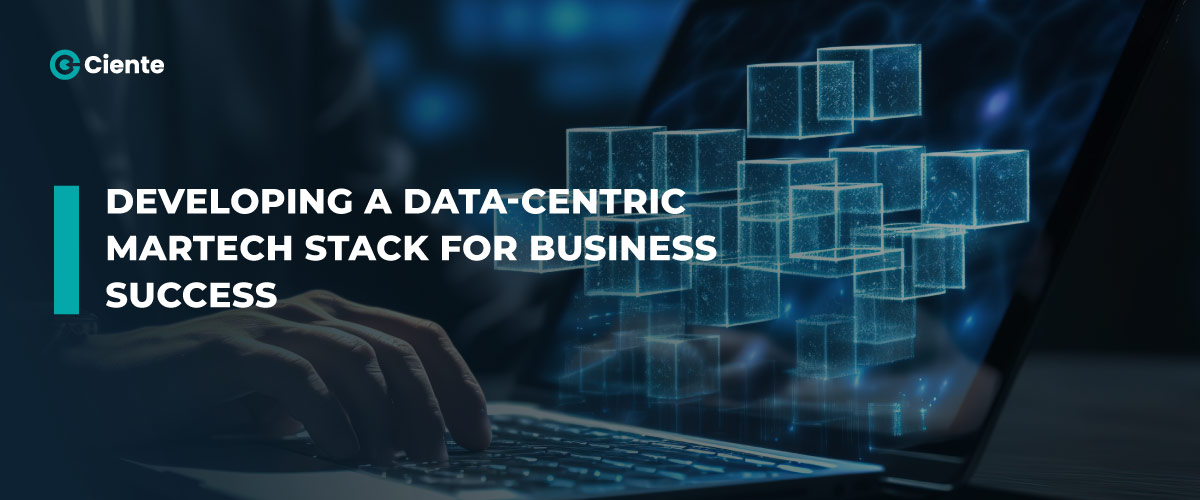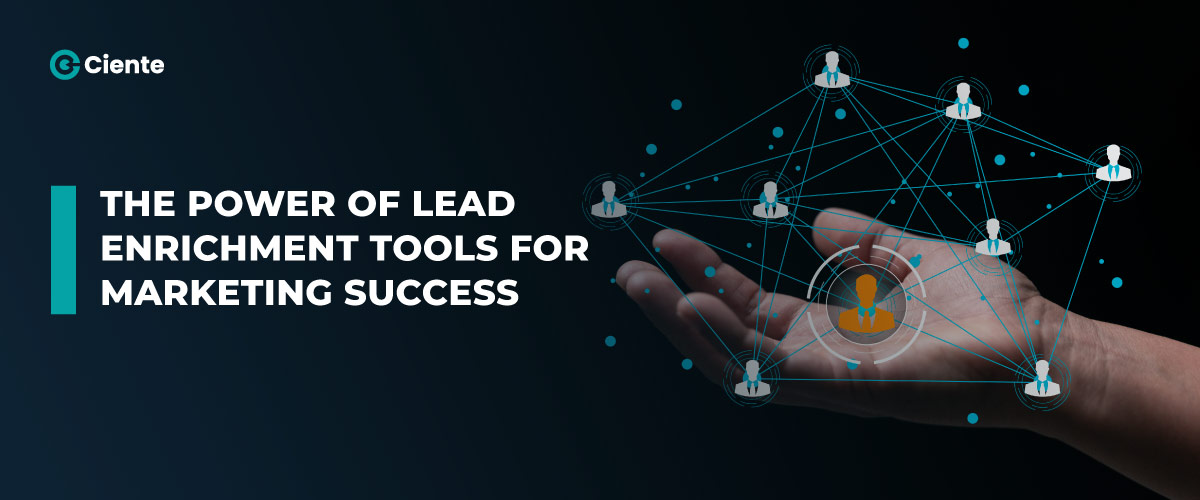Developing a Data-Centric Martech Stack for Business Success
From a click to a view, everything is a data point for businesses to profit from if used with the right martech stack. Is your organization well-stacked?
In the age where every click, view, and interaction is a data point, businesses find themselves both blessed and burdened by the magnitude of data. The challenge for organizations lies not merely in gathering this extensive data but in leveraging it effectively to have a competitive advantage. This necessity has propelled the strategic adoption of a data-driven marketing technology (martech) framework from a beneficial asset to an essential component of success.
As competition escalates across industries, having a seamlessly integrated martech framework is crucial for making informed decisions that boost customer engagement and stimulate growth. This is why, in this article, we’re discussing how to develop a data-centric market stack, its key components, and what martech stacks will be like in the future.
But first, what is a data-centric martech stack?
The introduction of a data-focused marketing technology framework for today’s businesses marks a significant shift. This framework is not just a selection and collective combination of tech tools; it’s a strategic approach that prioritizes data at the heart of marketing, ensuring decisions are guided by comprehensive insights into consumer actions and market dynamics and not by mere intuition. This integrated system combines the capabilities of Customer Data Platforms (CDPs), analytics and Business Intelligence (BI) solutions, marketing automation technologies, and data integration mechanisms into a cohesive unit. Its strength is converting extensive datasets into actionable intelligence, facilitating tailored customer interactions and informed strategic choices.
This framework signals a move away from traditional, gut-feel marketing towards a process that molds strategies through the precise application of data analytics. This change not only boosts the efficacy of marketing campaigns but also drives companies toward achieving unmatched customer engagement and loyalty levels. This is why, across the globe, about 26.6% of marketing funds in organizations are specifically dedicated to expenditures on MarTech.
The key components of a Sophisticated Data-Centric Marketing Technology Framework
The strategic assembly of a sophisticated marketing technology framework centered on data stands as the crucial foundation for enterprises aiming to secure their competitive edge and forge deeper connections with their clientele. This extends beyond mere tool aggregation; it’s about creating an interconnected ecosystem capable of dynamically interpreting and leveraging data as a strategic asset.
1. Centralized Customer Data Platforms (CDPs)
At the core of this sophisticated framework lies the Customer Data Platform (CDP). Its significance in the realm of customized or personalized marketing efforts is paramount. By gathering customer data from a multitude of sources into a cohesive customer profile, CDPs eradicate the fragmented understanding of customer engagements.
This consolidated perspective allows marketers to devise personalized communications, making each customer feel uniquely acknowledged. In an environment that is usually filled with impersonal and not-so-direct advertising, the capability to personalize emerges not just as a competitive advantage but as a fundamental necessity.
2. Insightful Analytics and Business Intelligence
Serving as the analytical brainpower of the operation, data analytics, and business intelligence tools transcend mere data processing. They animate the data, translating metrics and numbers into narratives and actionable insights.
Advanced algorithms and machine learning techniques are at the core of these platforms, uncovering patterns in consumer actions, pinpointing opportunities, and tracking emerging trends. This enables marketers to refine their advertising efforts for optimal effectiveness through informed, data-backed choices. By transitioning their marketing approaches from reactive to proactive methods, companies are better positioned to outpace their competitors.
3. Seamless Data Integration
Data integration tools, the third pillar, are pivotal in achieving operational synergy and effectiveness within the marketing technology framework. Today, data is dispersed across an array of platforms and channels. This data remains isolated, undeveloped, and underutilized in the absence of an all-encompassing integration plan.
Integration tools merge these diverse data streams into a unified entity, enabling every component of the marketing stack to access and employ the entire data spectrum. This integration facilitates real-time responsiveness to consumer behaviors, supporting a dynamic and adaptive marketing strategy.
4. Efficient LOW Data Platforms:
The LOW (Load-Once, Write-Many) Data Platform emerges as a foundational element within the data-centric marketing framework. This solution tackles the complexities of handling large data volumes by enabling efficient storage, modification, and retrieval of data. At its core, this method ensures that once data enters the system, it’s readily available for use across various applications without the need for replication. This operational efficiency is critical in a landscape where agility and quick response are valued. By minimizing data management overhead, organizations can concentrate on innovation and strategic planning.
5. Comprehensive Marketing Analytics
Marketing analytics, the final pillar, is concerned with analyzing and improving the effectiveness of marketing efforts. Organizations can enhance their plans with the help of marketing analytics solutions, which provide detailed insights into campaign results, customer engagement, and ROI. This analytical perspective allows marketers to discern the most effective tactics, directing resources toward the most productive channels and strategies.
Step-by-step guide to building a data-centric Martech stac
1. Clarify Marketing Goals
Initiating the process of building a data-focused martech ensemble begins with articulating your marketing objectives. Are your targets set on elevating customer acquisition, enhancing engagement, or amplifying conversion rates? These goals will make the path toward selecting the appropriate tools and technologies for your team clear.
2. Evaluate Current Technologies
As per the research done by Statista, the number of martech solutions available has significantly increased in the past few years, from just 150 in 2011 to over 11,038 in 2023.

Look for and evaluate the arsenal of tools and platforms presently at your disposal. Understand and pinpoint existing capability gaps or instances where data may be divided. This evaluation sheds light on necessary additions or adjustments to your toolset, ensuring a cohesive and functional martech ensemble by understanding your existing technological framework.
1. Opt for Compatible Tools
The potency of a data-focused martech ensemble is rooted in the seamless interplay and communication between its components. Favor tools that boast open APIs and extensive integration features. This choice guarantees the unobstructed circulation of data throughout your team, bolstering the efficiency and impact of your marketing endeavors.
2. Emphasize Data Security and Adherence to Regulations
When organizations are navigating today’s regulatory climate, prioritizing data security and conforming to legal standards like the GDPR and CCPA is crucial. Each part of your marketing technology setup must adhere to these rules. The importance of securing customer data goes beyond just fulfilling legal mandates; it’s about building and preserving consumer trust.
3. Deploying and Looking at the Future
Deploying your martech ensemble marks the commencement of an iterative journey. It’s vital to monitor its output and the insights it yields perpetually. Be agile in adjusting and refining your ensemble as necessary. This might involve experimenting with different configurations of tools, integrating new technologies in response to evolving marketing objectives, or discarding tools that no longer contribute to your strategy.
The Future of Data-Centric Martech
Prioritizing Ethical Data Practices
In a time increasingly driven by data-centric technologies, the principled handling of data will become a critical aspect of a brand’s reputation. Organizations that commit to handling data transparently and with respect stand to not only smoothly operate within regulatory frameworks but also build trust and loyalty among consumers who are increasingly aware of their privacy. This calls for the development of marketing technologies that inherently consider privacy, maintaining personalized consumer experiences without infringing upon their control over personal data.
Embracing Decentralized Data Ownership Models
Looking forward, we might see a shift towards decentralized models of data ownership, challenging the prevailing centralized data control mechanisms. Innovations such as blockchain hint at a future where consumers directly manage their digital identities, selectively sharing access with companies in return for customized services. This development could radically alter data privacy dynamics and remodel the marketing technology stack into a lattice of permission-based exchanges, fundamentally changing how data is collected and utilized.
Merging Physical and Digital Experiences
With the development of AR and VR, the line between online and physical experiences is starting to dissolve, opening up new possibilities for marketers. This progression demands marketing technologies capable of integrating digital and tangible data, enabling marketers to design engaging experiences that span both dimensions. Envision AR-enhanced shopping spaces that adapt in real-time to online consumer behaviors, or VR marketing initiatives that transport individuals to digitally crafted realms personalized to their preferences.
Transitioning from Big Data to Deep Data
The pursuit of expansive data sets has often overshadowed the depth and detail within “deep data.” The future suggests a shift towards more qualitative data analysis, focusing on depth rather than breadth. This approach emphasizes extracting profound, personal insights from data, using sophisticated analytics to reveal the stories hidden within. For marketers, this means adopting technologies capable of delving into data’s depths to uncover authentic human stories, driving campaigns that connect on a deeper emotional level.
Conclusion
Embracing data analytics to enhance marketing technology strategies is a major step forward for digital leadership. This development goes much beyond a simple strategy shift; it heralds a fundamental shift in the way businesses use data to fuel expansion, personalize customer experiences, and create exciting new opportunities. Having a data-centric approach in martech is imperative to not only stay relevant but also to set the stage for future growth and establish a lead position in the next phase of digital innovations for those riding the digital wave’s front.








